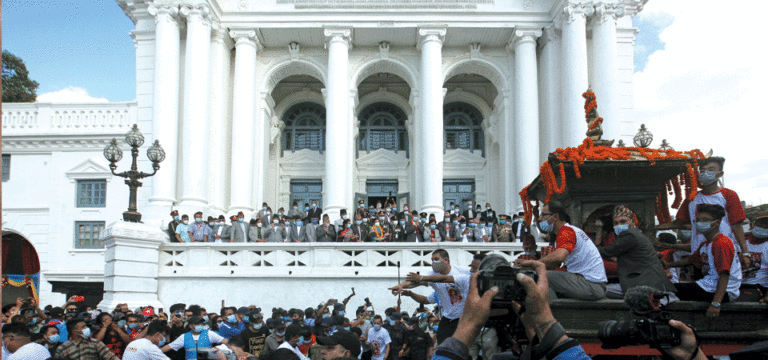
As has been the custom for centuries, President Bidya Devi Bhandari circumambulated the chariot of living goddess Kumari on Sunday and received tika from her hands as the head of state of Nepal. She also paid respects to the two living gods, Ganesh and Bhairav.
Prime Minister Sher Bahadur Deuba, heads of constitutional bodies, diplomats, political leaders and chiefs of security bodies also joined her at Hanumandhoka and observed the Indra Jatra from the balcony of the Gaddi Baithak.
But a question springs to mind. Why, if the Kumari is so important that the head of state needs to obtain her blessings, is the jatra she is a part of named after another deity? Indeed, why is an eight-day festival featuring numerous dances, rituals and divinities only called Indra Jatra?
Well, this is because the name could be a misrepresentation, culture experts believe. In fact, the eponymous god may be a later addition altogether, according to art historian and culture expert Gautama Vajracharya.
In his book ‘Nepalese Seasons Rain and Ritual,’ Vajracharya explains that the Jatra originated as a celebration of nature and ancestors, not a specific god.
Heritage conservationist Alok Siddhi Tuladhar shares this view, for which, he gives the example of the ‘Indra’ figures that communities across Kathmandu put up on poles to mark the festival. “The figures are actually Bukhyacha (scarecrows),” he shared. “Scarecrows are very important for farmers because they keep birds from damaging crops. As members of an agrarian society, the people of Kathmandu chose to put up the dummies during the festival to honour their utility.”
Culture scholar Om Dhaubhadel also stated that the name ‘Indra Jatra’ did not fully acknowledge the scope and importance of the festival. “Indra Jatra is not just about Indra. It features many other characters and fables of Indra’s mother, the living gods, Majipat Lakhe and Bhairav. But the name does not reflect this,” he said, adding that the need associated the festival with Kathmandu only. “The festival is also celebrated in Lalitpur, Bhaktapur and Kirtipur. But because they are not called Indra Jatra, they get overshadowed.”
So, to recognise the true nature of this festival, it must be referred to by its original name ‘Yenya,’ Tuladhar and Dhaubhadel asserted.
The word ‘Yen’ or its alternate pronunciation ‘Yan’ denotes the Nepal Sambat month of Yanla in which the Jatra takes place and also refers to Indra in Nepal Bhasa.
“Yenya, as a historical term, has included all the festivities organised during the eight days of Indra Jatra and acknowledges the different communities organising them. Therefore, Yenya should be used as its proper name and ‘Indra Jatra’ can be kept as a cognomen,” Dhaubhadel said.
Talking to The Rising Nepal, historian Basanta Maharjan also remarked that calling Yenya Indra Jatra would be erroneous because of several differences between the Vedic
Indra and the Yamadya (Indra) of Kathmandu Valley.
The mother of Indra in Hinduism is Goddess Aditi while the mother of Indra in Yenya is the demon Dagi. The Basundhara Puja, for which Aditi needed the night jasmine (Parijat) flowers, is a Puja prevalent among Buddhists more than Hindus. And, while the tale of Indra Jatra states that Indra came to Earth to steal the Parijat flowers, many, especially in Bhaktapur, believe that it was Indra’s son Jayanta who came.
“So, it would be more accurate to call the festival Yenya rather than link it to Indra,” Maharjan said.
According to historians, the name Yenya (Yen being a Kiranti word) is also reflective of the pre-Hindu roots of the festival under the Kirant kings of Kathmandu.
This theory is supported by journalist, artist and conservationist Desmond Doig in his book ‘In the Kingdom of Gods’ where he states that the Swet Bhairav mask put on display during Indra Jatra is actually the bejewelled mask Kirant King Yalambar wore to the battle of Mahabharat.
Similarly, Doig also shares what he calls a more scholarly tale for Indra Jatra where Yalambar defeated and captured the king of an invading army and hung him on a pole for all to see. This practice later acquired religious symbolism and became Yenya.
“Native names carry overt and covert meanings. They impart knowledge and entice people to learn more.
That is why they should be preserved and that is why Indra Jatra, which is not only Indra’s Jatra, should be called by its original name Yenya,” Tuladhar stressed.
Indra Jatra falls on the fourth day of the waxing moon in the month of Bhadra of Ashoj every year as per the lunar calendar. This year, Indra Jatra officially started on Saturday after the erection of the ceremonial Yansi pole in front of the Hanumandhoka palace.
The Jatra is celebrated by both Hindus and Buddhists in localities all over Kathmandu Valley as well as Dolakha and Kavre.
Source : TRN,





